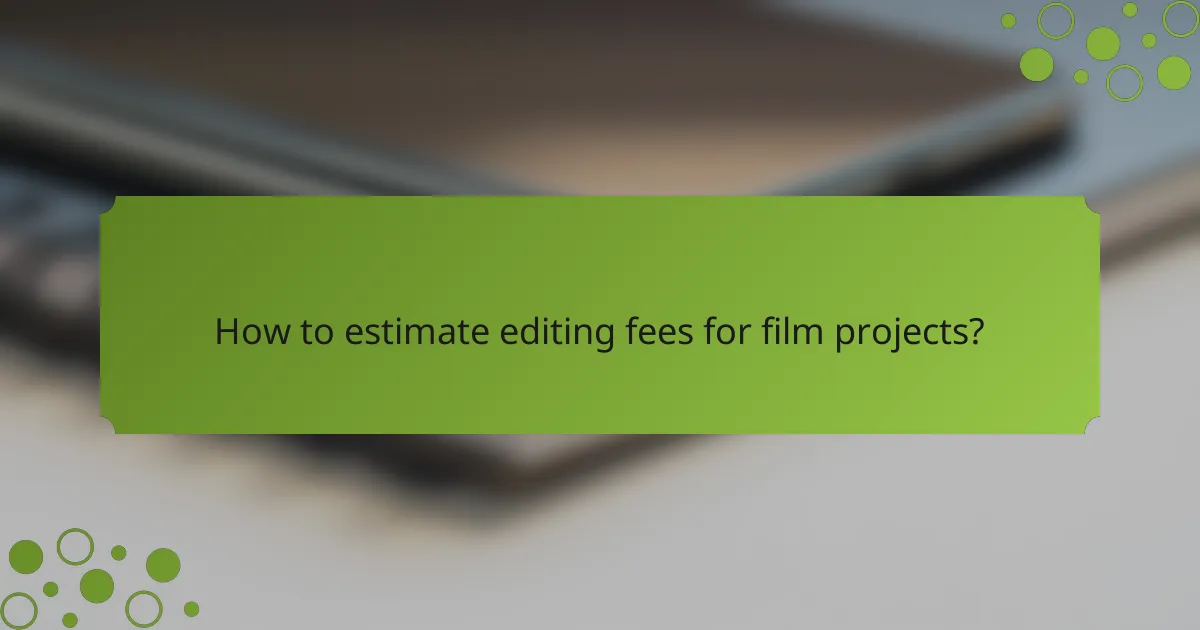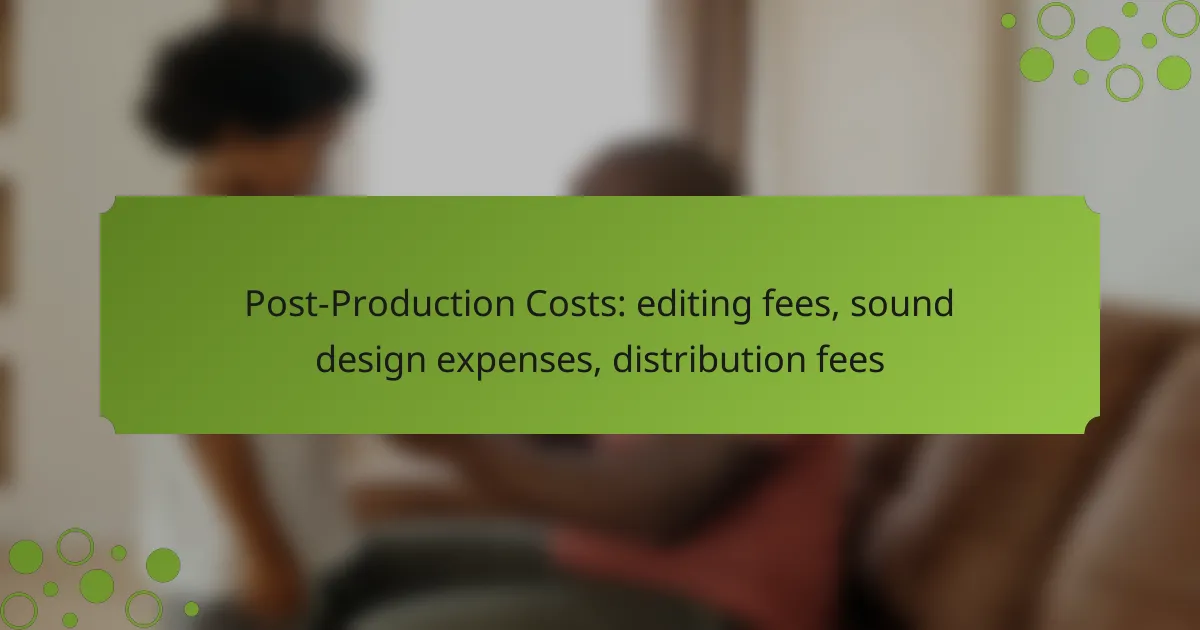Post-production costs play a crucial role in the overall budget of film and video production, encompassing various essential services such as editing fees, sound design expenses, and distribution fees. Understanding these costs is vital for filmmakers, as they can vary significantly based on project complexity and specific requirements. By carefully estimating these expenses, creators can ensure a polished final product that meets industry standards.

What are the typical post-production costs in Australia?
Post-production costs in Australia can vary significantly based on the complexity of the project and the services required. Generally, these costs encompass editing fees, sound design expenses, and distribution fees, each contributing to the overall budget of a film or video production.
Editing fees in Australian dollars
Editing fees in Australia typically range from AUD 50 to AUD 150 per hour, depending on the editor’s experience and the project’s demands. For a feature film, total editing costs can range from AUD 10,000 to AUD 50,000 or more, influenced by the length and complexity of the footage.
When budgeting for editing, consider the type of editing required, such as rough cuts, fine cuts, and color grading. Hiring a seasoned editor may increase costs but can significantly enhance the final product’s quality.
Sound design expenses in Australia
Sound design expenses in Australia can vary widely, with costs typically falling between AUD 1,000 and AUD 10,000 for independent films. This range depends on the project’s scale, the complexity of sound effects, and whether original music is composed.
Investing in high-quality sound design is crucial, as it enhances the viewer’s experience. Collaborating with experienced sound designers can help ensure that the audio complements the visual elements effectively.
Distribution fees for Australian films
Distribution fees for Australian films can range from AUD 5,000 to AUD 50,000, depending on the distribution strategy and platforms chosen. Costs may include marketing, festival submissions, and physical distribution, such as DVDs or Blu-rays.
When planning for distribution, consider the target audience and the most effective channels for reaching them. Engaging a distribution consultant can provide valuable insights and help navigate the complexities of the distribution landscape.

How to estimate editing fees for film projects?
Estimating editing fees for film projects involves understanding the scope of the work and the specific requirements of your project. Factors such as the length of the footage, complexity of edits, and the editor’s experience level will significantly influence the overall costs.
Factors affecting editing costs
Several key factors impact editing costs, including the duration of the raw footage, the type of edits required, and any additional services like color grading or sound design. Longer projects typically incur higher fees due to the increased time and effort needed for editing.
Moreover, the complexity of the edits plays a crucial role. Simple cuts and transitions are less expensive than intricate visual effects or advanced storytelling techniques. Additionally, the editor’s experience and reputation can also affect pricing, with seasoned professionals charging premium rates.
Average hourly rates for editors in Australia
In Australia, average hourly rates for film editors can range from AUD 50 to AUD 150, depending on their expertise and the project’s demands. Entry-level editors may charge lower rates, while highly experienced editors or those with specialized skills can command higher fees.
For a more accurate estimate, consider the specific needs of your project. For example, a documentary may require different editing skills compared to a narrative film, which could influence the hourly rate. Always discuss your project details with potential editors to get tailored quotes that reflect the required work.

What are sound design expenses for video production?
Sound design expenses in video production refer to the costs associated with creating and enhancing audio elements to improve the overall quality of a project. This includes tasks such as sound editing, mixing, and the addition of sound effects, which are crucial for achieving a professional soundscape.
Common sound design services and their costs
Common sound design services include sound editing, sound effects creation, and audio mixing. The costs for these services can vary widely based on the complexity of the project and the experience of the sound designer. For instance, sound editing might range from a few hundred to several thousand dollars, depending on the length and intricacy of the video.
Sound effects creation typically costs between $50 to $150 per effect, while audio mixing can range from $300 to $1,500 for a full project. It’s essential to budget for these services early in the production process to avoid unexpected expenses later.
Freelance sound designer rates in Australia
Freelance sound designer rates in Australia can vary based on experience and project requirements. Generally, rates range from AUD 50 to AUD 150 per hour. More experienced designers may charge higher rates, reflecting their expertise and the quality of their work.
When hiring a freelance sound designer, consider their portfolio and previous work to ensure they align with your project’s needs. It’s advisable to discuss the scope of work and negotiate a flat fee for larger projects to manage costs effectively.

How to budget for distribution fees?
Budgeting for distribution fees involves understanding the various costs associated with getting your film to audiences. These fees can vary widely based on the platforms you choose and the specific requirements of your distribution strategy.
Distribution platforms and their fees
Different distribution platforms have unique fee structures that can impact your budget. For example, popular streaming services may charge a flat fee or a percentage of revenue generated from your film. Some platforms require upfront payments, while others may take a cut of sales or rentals.
It’s essential to research each platform’s terms. For instance, platforms like Amazon Prime Video may charge around 15-30% of rental or purchase revenue, while others like Vimeo On Demand might have a more straightforward fee structure. Always read the fine print to avoid unexpected costs.
Cost considerations for film festivals in Australia
Submitting your film to festivals in Australia can incur various costs, including entry fees, travel, and promotional materials. Entry fees can range from AUD 20 to AUD 100 or more, depending on the festival’s prestige and size.
Additionally, consider costs for attending the festival, such as travel and accommodation. If your film is selected, you may also need to budget for marketing materials and screenings. Always plan for these expenses to ensure you maximize your festival experience without overspending.

What are the prerequisites for budgeting post-production?
Budgeting for post-production requires a clear understanding of the project’s scope and the specific costs associated with editing, sound design, and distribution. Identifying these elements early on helps in allocating resources effectively and avoiding unexpected expenses.
Essential elements to include in a budget
When creating a post-production budget, include costs for editing, sound design, visual effects, color correction, and distribution. Each of these elements can vary significantly based on the project’s complexity and the professionals involved.
For example, editing fees can range from a few hundred to several thousand dollars, depending on the editor’s experience and the project’s length. Sound design expenses may also vary, with basic sound editing starting around a few hundred dollars, while more complex projects could reach into the thousands.
Common mistakes in post-production budgeting
A frequent mistake in post-production budgeting is underestimating the time required for editing and sound design. Many projects take longer than initially anticipated, leading to increased costs. It’s essential to build in a buffer for unexpected delays.
Another common pitfall is neglecting distribution fees, which can include costs for festival submissions, marketing materials, and digital platform fees. Failing to account for these can result in a budget that is insufficient for getting the project to its audience.

What are the emerging trends in post-production costs?
Emerging trends in post-production costs highlight the influence of technology and evolving practices in the industry. As digital tools become more sophisticated, costs for editing and sound design are shifting, often leading to both savings and new expenses for filmmakers.
Impact of technology on editing costs
Technology significantly affects editing costs by introducing more efficient software and hardware solutions. High-performance editing systems and cloud-based platforms allow for faster workflows, which can reduce labor costs. However, initial investments in advanced technology can be substantial, often ranging from a few hundred to several thousand dollars.
Additionally, the rise of remote collaboration tools enables teams to work together from different locations, potentially lowering costs associated with travel and studio rentals. Filmmakers should weigh the benefits of these technologies against their budgets to determine the best approach for their projects.
Future of sound design expenses with AI tools
The integration of AI tools in sound design is transforming how audio is created and managed, often leading to reduced costs. AI can automate repetitive tasks, such as noise reduction and sound matching, which can save time and resources. While traditional sound design may require specialized skills and significant hours, AI can streamline these processes, potentially cutting costs by a notable percentage.
However, filmmakers should be cautious about over-relying on AI, as it may not fully replicate the creativity and nuance that human sound designers bring. Balancing AI tools with skilled professionals can ensure high-quality sound while managing expenses effectively.
